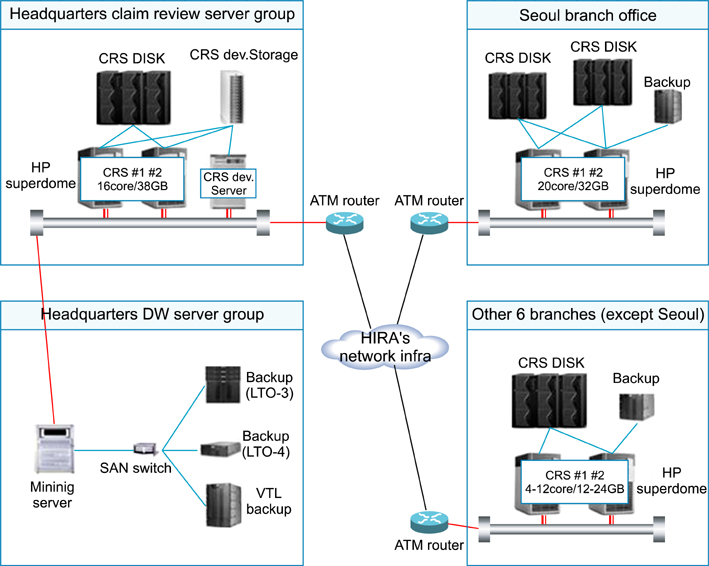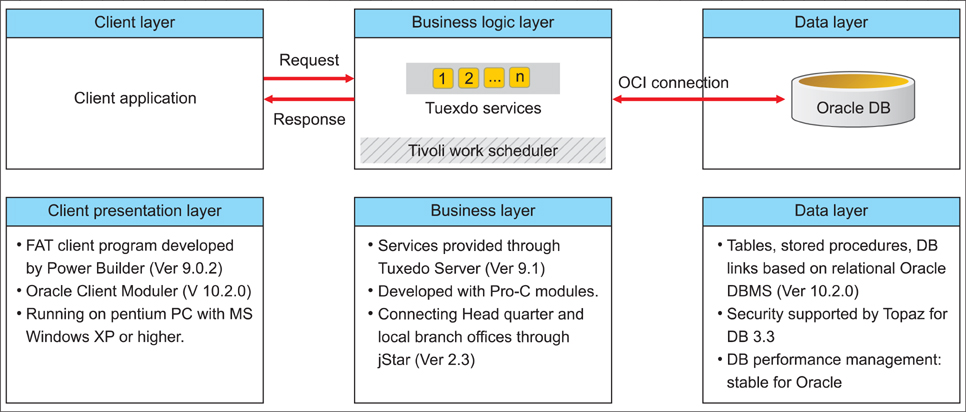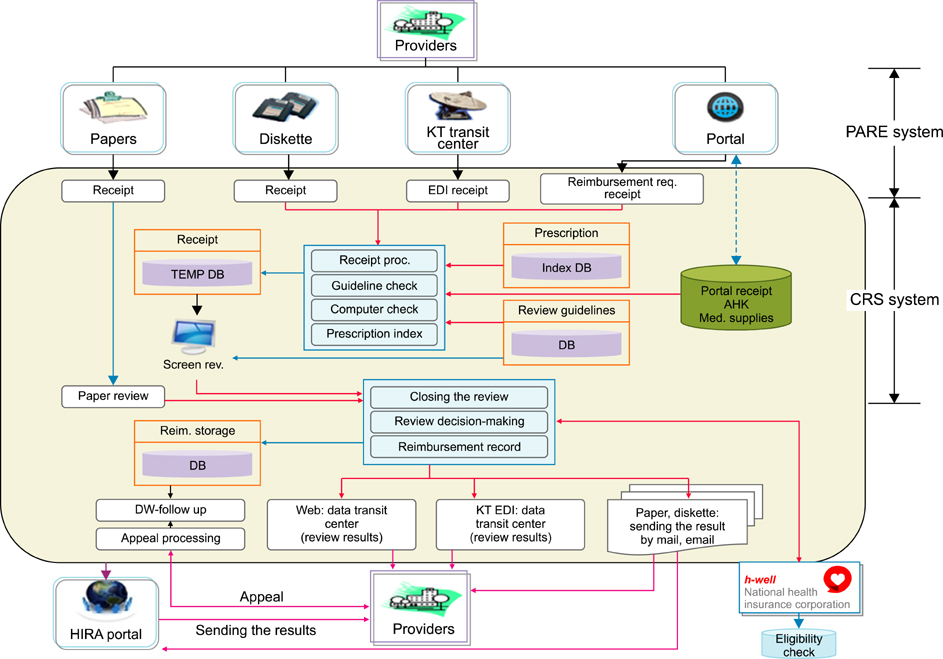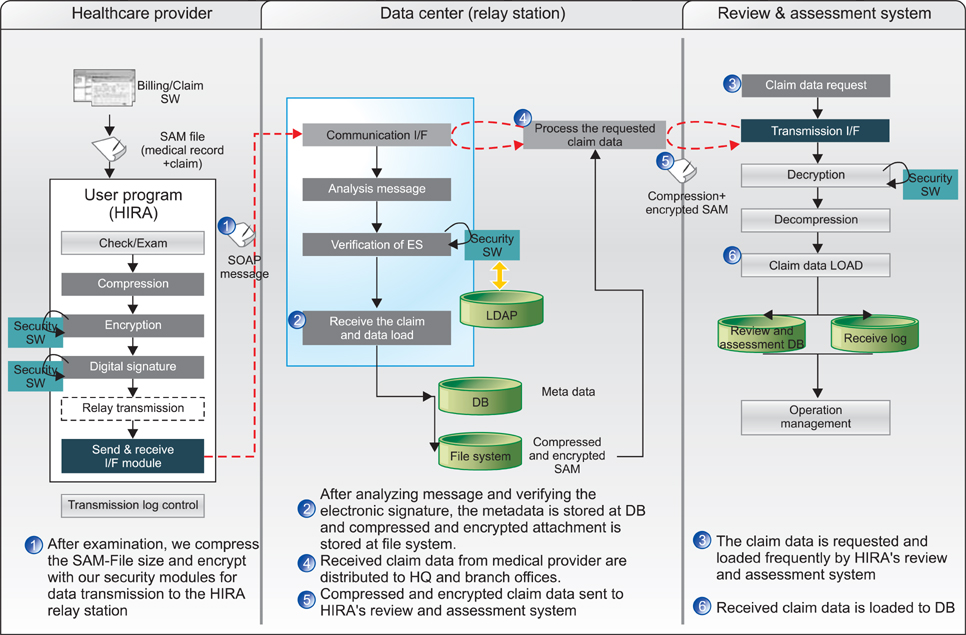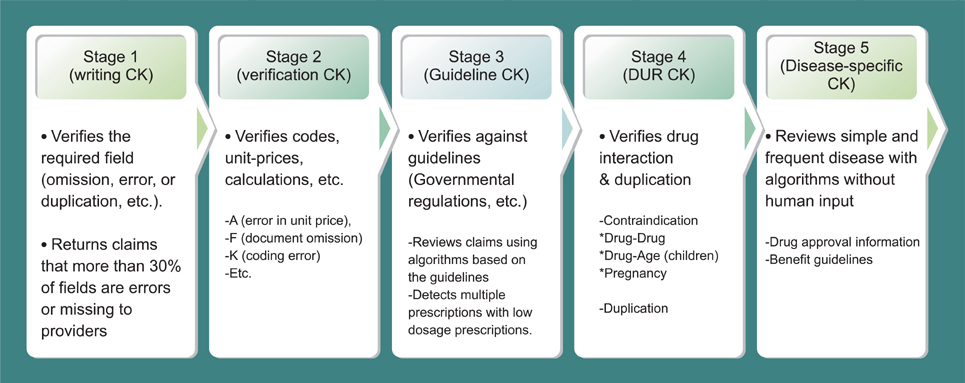Health Insurance Claim Review Using Information Technologies
- Affiliations
-
- 1Health Insurance Review & Assessment Research Institute, Seoul, Korea. pyt0601@hiramail.net
- 2Department of International Cooperation, Health Insurance Review & Assessment Service, Seoul, Korea.
- 3Institute for Health Informatics, University of Minnesota, Minneapolis, MN, USA.
- 4Department of Medicine, VA Loma Linda Healthcare System, Loma Linda, CA, USA.
- KMID: 2229473
- DOI: http://doi.org/10.4258/hir.2012.18.3.215
Abstract
OBJECTIVES
The objective of this paper is to describe the Health Insurance Review and Assessment Service (HIRA)'s payment request (PARE) system that plays the role of the gateway for all health insurance claims submitted to HIRA, and the claim review support (CRS) system that supports the work of claim review experts in South Korea.
METHODS
This study describes the two systems' information technology (IT) infrastructures, their roles, and quantitative analysis of their work performance. It also reports the impact of these systems on claims processing by analyzing the health insurance claim data submitted to HIRA from April 1 to June 30, 2011.
RESULTS
The PARE system returned to healthcare providers 2.7% of all inpatient claims (97,930) and 0.1% of all outpatient claims (317,007) as un-reviewable claims. The return rate was the highest for the hospital group as 0.49% and the lowest rate was found in clinic group. The CRS system's detection rate of the claims with multiple errors in inpatient and outpatient areas was 23.1% and 2.9%, respectively. The highest rate of error detection occurred at guideline check-up stages in both inpatient and outpatient groups.
CONCLUSIONS
The study found that HIRA's two IT systems had a critical role in reducing heavy administrative workloads through automatic data processing. Although the return rate of the problematic claims to providers and the error detection rate by two systems was low, the actual count of the returned claims was large. The role of IT will become increasingly important in reducing the workload of health insurance claims review.
Keyword
MeSH Terms
Figure
Cited by 7 articles
-
Data Configuration and Publication Trends for the Korean National Health Insurance and Health Insurance Review & Assessment Database
Hae Kyung Kim, Sun Ok Song, Junghyun Noh, In-Kyung Jeong, Byung-Wan Lee
Diabetes Metab J. 2020;44(5):671-678. doi: 10.4093/dmj.2020.0207.Epidemiology of Congenital Bleeding Disorders: a Nationwide Population-based Korean Study
Hoi Soo Yoon, Yujin Han, Young Jin Kim, Min Jin Kim, Ja Min Byun, Taemi Youk, Jae Hee Lee, Tae Sung Park, Jongha Yoo
J Korean Med Sci. 2020;35(39):e350. doi: 10.3346/jkms.2020.35.e350.Clinical Significance of National Patients Sample Analysis: Factors Affecting Mortality and Length of Stay of Organophosphate and Carbamate Poisoned Patients
Kyoung-Ho Kim, In Ho Kwon, Jun Yeob Lee, Woon Hyung Yeo, Ha Young Park, Kyung Hye Park, Junho Cho, Hyunjong Kim, Gun Bea Kim, Deuk Hyun Park, Yoo Sang Yoon, Yang Weon Kim
Healthc Inform Res. 2013;19(4):278-285. doi: 10.4258/hir.2013.19.4.278.Healthcare Utilization Monitoring System in Korea
Hyun Chul Shin, Young-Taek Park, Youn Tae Lee, Emmanuel C. Jo
Healthc Inform Res. 2015;21(3):184-190. doi: 10.4258/hir.2015.21.3.184.Incidence of Adult In-Hospital Cardiac Arrest Using National Representative Patient Sample in Korea
Yuri Choi, In Ho Kwon, Jinwoo Jeong, Junyoung Chung, Younghoon Roh
Healthc Inform Res. 2016;22(4):277-284. doi: 10.4258/hir.2016.22.4.277.Association between Full Electronic Medical Record System Adoption and Drug Use: Antibiotics and Polypharmacy
Young-Taek Park, Donghwan Kim, Rae Woong Park, Koray Atalag, In Ho Kwon, Dukyong Yoon, Mona Choi
Healthc Inform Res. 2020;26(1):68-77. doi: 10.4258/hir.2020.26.1.68.Incidence and Treatment Pattern of Extremity Soft Tissue Sarcoma in Korea, 2009-2011: A Nationwide Study Based on the Health Insurance Review and Assessment Service Database
Seungcheol Kang, Han-Soo Kim, Eun-Seok Choi, Ilkyu Han
Cancer Res Treat. 2015;47(4):575-582. doi: 10.4143/crt.2014.047.
Reference
-
1. Health Insurance Review & Assessment Service (HIRA). Review and assessment activities, part 1. 2011. Seoul, Korea: HIRA.2. Hodges J. Effective claims denial management enhances revenue. Healthc Financ Manage. 2002. 56(8):40–50.3. Remler DK, Gray BM, Newhouse JP. Does managed care mean more hassle for physicians? Inquiry. 2000. 37(3):304–316.4. Sakowski JA, Kahn JG, Kronick RG, Newman JM, Luft HS. Peering into the black box: billing and insurance activities in a medical group. Health Aff (Millwood). 2009. 28(4):w544–w554.
Article5. Morra D, Nicholson S, Levinson W, Gans DN, Hammons T, Casalino LP. US physician practices versus Canadians: spending nearly four times as much money interacting with payers. Health Aff (Millwood). 2011. 30(8):1443–1450.
Article6. Shekelle PG, Morton SC, Keeler EB. Costs and benefits of health information technology. Evid Rep Technol Assess (Full Rep). 2006. (132):1–71.
Article7. Park YT. Healthcare IT business forum: management of a national health insurance system using information technology. Proceedings of the 3rd Global Healthcare & Medical Tourism Conference. 2012 Apr 17-19; Seoul, Korea. 69–84.8. Statistics Korea. Estimates of future population 2010-2060 [Internet]. c2012. cited at 2012 Sep 15. Daejeon: Statistics Korea;Available from: http://www.index.go.kr/egams/stts/jsp/potal/stts/PO_STTS_IdxSearch.jsp?idx_cd=1009&stts_cd=100901&clas_div=C&idx_sys_cd=&idx_clas_cd=1.9. Health Insurance Review & Assessment Service (HIRA). 2011 Annual business performance report. 2012. Seoul, Korea: HIRA.10. Segal MJ, Morris S, Rubin JM. Automated claim and payment verification. J Med Pract Manage. 2002. 17(6):297–301.11. Galbraith JR. Designing complex organizations. 1973. Reading (MA): Addison-Wesley.12. Chae YM, Yoo KB, Kim ES, Chae H. The adoption of electronic medical records and decision support systems in Korea. Healthc Inform Res. 2011. 17(3):172–177.
Article13. Henricks WH. "Meaningful use" of electronic health records and its relevance to laboratories and pathologists. J Pathol Inform. 2011. 2:7.
Article14. Kim J, Jung H, Bates DW. History and trends of "personal health record" research in PubMed. Healthc Inform Res. 2011. 17(1):3–17.
Article15. Devine EB, Hansen RN, Wilson-Norton JL, Lawless NM, Fisk AW, Blough DK, et al. The impact of computerized provider order entry on medication errors in a multispecialty group practice. J Am Med Inform Assoc. 2010. 17(1):78–84.
Article16. Herrick DM, Gorman L, Goodman JC. Policy report no.: 327. Healthcare information technology: benefits and problems. 2010. Dallas (TX): National Center for Policy Analysis.
- Full Text Links
- Actions
-
Cited
- CITED
-
- Close
- Share
- Similar articles
-
- A guide for the utilization of Health Insurance Review and Assessment Service National Patient Samples
- Emerging New Era of Mobile Health Technologies
- Comorbidity Adjustment in Health Insurance Claim Database
- Development of an Electronic Claim System Based on an Integrated Electronic Health Record Platform to Guarantee Interoperability
- Knowledge of Insurance Claim for ERCP Beginner

